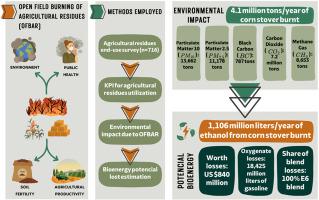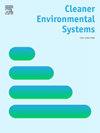Impacts assessment of open field burning of agricultural residues in Mexico
IF 4.9
Q2 ENGINEERING, ENVIRONMENTAL
引用次数: 0
Abstract
This research estimates the number of agricultural residues burned in open field, their pollutant emissions and the energy lost in the 2,476 municipalities that make up Mexico. The emissions of Particulate Matter 10 (PM10) and 2.5 (PM2.5), Black Carbon (BC), Carbon Dioxide (CO2) and Methane Gas (CH4) at the municipal level were estimated. The bioenergy loss was also estimated, in terms of anhydrous ethanol. In addition, the economic value lost was estimated, as well as the amount of gasoline that could have been oxygenated at 6 % volume and the percentage of participation in the national gasoline demand. The results, aggregated at the national level, show that Mexico annually incinerates 4.1 million tons of corn stover which emits 13,662 tons of PM10, 11,178 tons of PM2.5, 787 tons of BC, 7.2 million tons of CO2 and 8,653 tons of CH4 to the atmosphere. If this amount of biomass were used to produce anhydrous ethanol, a volume of 1,106 million liters, worth US$840 million, could be produced, which might also be used to oxygenate 18,425 million liters of gasoline, covering approximately 100 % of the national demand for this biofuel. The results provide empirical evidence on open burning of agricultural residues in Mexico and can be used to design public policies to reduce the country's share of global pollutant emissions.

墨西哥露天焚烧农业残留物的影响评价
这项研究估计了墨西哥2476个城市在露天焚烧的农业残留物的数量、它们的污染物排放和能源损失。估算了各城市颗粒物10 (PM10)和2.5 (PM2.5)、黑碳(BC)、二氧化碳(CO2)和甲烷气体(CH4)的排放量。对无水乙醇的生物能量损失也进行了估计。此外,还估计了经济价值的损失,以及可以以6%的体积氧化的汽油量和参与国家汽油需求的百分比。结果显示,墨西哥每年焚烧410万吨玉米秸秆,向大气排放13662吨PM10、11178吨PM2.5、787吨BC、720万吨CO2和8653吨CH4。如果用这种数量的生物质生产无水乙醇,则可生产11.06亿升,价值8.4亿美元,还可用于氧化184.25亿升汽油,约可满足全国对这种生物燃料的100%需求。研究结果为墨西哥露天焚烧农业残留物提供了经验证据,并可用于设计公共政策,以减少该国在全球污染物排放中的份额。
本文章由计算机程序翻译,如有差异,请以英文原文为准。
求助全文
约1分钟内获得全文
求助全文
来源期刊

Cleaner Environmental Systems
Environmental Science-Environmental Science (miscellaneous)
CiteScore
7.80
自引率
0.00%
发文量
32
审稿时长
52 days
 求助内容:
求助内容: 应助结果提醒方式:
应助结果提醒方式:


